*The article below is an excerpt from the above Sefer
*As an Amazon Associate I earn from qualifying purchases.
- No Shechinah: During the era of the second Temple, being that it did not contain the Aron and the Luchos within the Holy of Holies, the sages state that the Shechinah did not dwell in it.
- No Shechinah of above Seder Hishtalshelus: This means as follows: The level of Shechinah which dwelled in the first Temple, which skipped the chain order of the worlds [i.e. Seder Hishtalshelus], did not dwell in the second Temple.
- A Shechinah of Seder Hishtalshelus: However, the level of Shechinah which passes through the chain descent of the worlds [Seder Hishtalshelus] did reside in the second Temple. On this level, the Shechinah, which is Malchus of Atzilus, descends into Malchus of Beriya and Malchus of Beriya descends into Malchus of Yetzirah, and Malchus of Yetzirah descends into the Kodesh Hakedoshim of Assiya, and the Kodesh Hakedoshim of Assiya would then invest itself into the Kodesh Hakedoshim of the Temple below. The Shechinah, which is Malchus of Yetzirah as its invested in the Kodesh Hakedoshim of Assiya, would thus reside in the second Temple.
- No entry even in 2nd Temple: It is for this reason that no person had permission to enter the Kodesh Hakedoshim other than the Kohen Gadol on Yom Kippur.
- Where does the Shechinah reside during exile?
- Within the four Amos of Halacha: Since the Temple was destroyed, Hashem only dwells within the four Amos of Halacha.
- Within Torah learning of a single person: Even when a single person sits and learns Torah, the Shechinah is with him.
- The level of Shechinah-Assiyah: This refers to the Shechinah of Malchus of Atzilus, as it’s invested in Malchus of Beriya and Yetzirah and Assiya.
- All Mitzvos involve Assiyah-Action: The reason for why the Shechinah must pass through Malchus of Assiya is because the vast majority of the 613 Mitzvahs of the Torah involve physical action.
- Even Mitzvah’s of speech are considered an action: Even those Mitzvahs that are dependent on thought and speech, such as Talmud Torah and Birchas Hamazon and Kerias Shema and Tefilla, can only be fulfilled through the verbalization of the mouth and not through intent of the heart. Thinking of the words in one’s heart is not considered an action that suffices for the fulfillment of the Mitzvah, as we rule that thought is not like speech and one does not fulfill his obligation with mere thought and concentration alone until he actually verbalizes the words, as we rule that verbalization is considered an action.
- Gematria of Keser: The 613 Mitzvos together with the seven Rabbinical commands add up to the numerical value of 620 which is Keser.
- Contains the Ratzon Haelyon: Keser represents the supernal Divine will which is invested within G-d’s Chochmah and is united with His infinite light in complete unity.
- Halacha comes from Keser-Chochmah: Now, the Torah stems from this supernal wisdom, as the Zohar states that from Aba [i.e. Chochmah] comes the daughter [i.e. Torah Shebaal Peh]. [Hence, it is found that Jewish law derives directly from the wisdom and will of G-d, and hence contains within it the highest level of the Shechinah, as opposed to the study of other sections of Torah.]
Related Articles
Daily Tanya Sunday 16th Menachem Av Igeres Hakodesh 5 Part 2: Divine Speech in Creation
Post Views: 21 16th Av The Creation of the World The sages ask why this world was specifically created with the letter Hei (ה). The answer lies in the layered complexity and purposefulness of creation. Multiplicity of Worlds and Spiritual Beings There are countless worlds, palaces, and spiritual beings—angels and
Daily Tanya Tuesday 11th Menachem Av Igeres Hakodesh 4 Part 2: Spiritual Circumcision and Redemption
Post Views: 67 11th Av Divine and Human Roles in Spiritual Transformation An awakening from above only comes in response to an awakening from below; individuals must first initiate the process of spiritual refinement, much like the symbolic act of the “feminine waters” rising before the “masculine waters” descend. Removing
Daily Tanya Monday 10th Menachem Av Igeres Hakodesh 4: The Exile of the Heart and the Path to Redemption
Post Views: 77 The Challenge of Inner Service Not everyone attains deep, heartfelt service to the Divine, as the soul’s inner spiritual faculty can be in a state of exile. The Spiritual Exile This exile mirrors the Shechinah’s exile with the Jewish people, as described by the sages, when the
Daily Tanya Thursday 6th Menachem Av Igeres Hakodesh 2: The Danger of Pride in Receiving Kindness
Post Views: 127 Epistle 2: The Danger of Pride in Receiving Kindness 6th Av Responding to Divine Favors with Humility With every favor bestowed by G-d, a person should become more humble. Being brought closer to G-d requires ever-greater self-effacement, reflecting the principle that “all that are before Him are
Daily Tanya Wednesday 5th Menachem Av Igeres Hakodesh 1 Part 3: Accountability for Prayer Diligence
Post Views: 166 Who Should Lead Prayer on Weekdays During weekdays, those who have free time, such as teachers or individuals supported by their families, should serve as prayer leaders. Businesspeople, who typically lack the time, are generally exempt from this responsibility during the week. The one who leads prayer
Daily Tanya Tuesday 4th Menachem Av Igeres Hakodesh 1 Part 2: The Power and Purpose of Torah Study
Post Views: 183 The Foundation of Faith and Spiritual Strength Faith acts as the support for the intellectual and emotional faculties of the soul, enabling deep contemplation and emotional connection with the Divine. The study of the laws in the Oral Torah is essential, as it reveals the Supreme Divine


 Donate
Donate
Leave A Comment?
You must be logged in to post a comment.